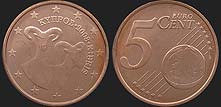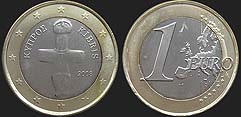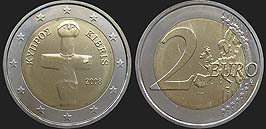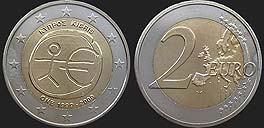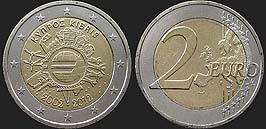CYPRUS (from 2008) - Cypriot euro coins [EUR]
1 euro = 100 euro cent
The preparations for the monetary union started in 1991 in Maastricht. In December 1995 in Madrid the name of the new currency was chosen. On January 1st, 1999 Euro [EUR] became an official (although virtual) currency in 11 countries of the European Union (Austria, Belgium, Finland, France, Germany, Ireland, Italy, Luxembourg, the Netherlands, Portugal and Spain). In 2001 Greece also joined the system. The first coins were minted already in 1999, but real money entered circulation only on January 1, 2002. The Eurozone was extended six times: in 2007 (Slovenia), 2008 (Cyprus and Malta), 2009 (Slovakia), 2011 (Estonia), 2014 (Latvia) and 2015 (Lithuania). Thus 19 countries belong to the eurozone today. Euro coins are also being issued by four small countries, which do not belong to the EU, but signed a special agreement with the EU: Andorra, Monaco, San Marino, and Vatican. Euro is the official currency also in Montenegro, Kosovo, and French overseas regions. About 340 millions of people use Euro everyday.
The common side, identical for all of the Euro issuers was chosen in a graphic competition won by Luc Luycx. On June 7, 2005 it was decided to change the design of the common side of euro coins. Coins with face values 10, 20 and 50 cents as well as 1 and 2 euros issued after January 1, 2007 show a full map of Europe without political borders. Coins issued by Italy (including San Marino and Vatican), Austria and Portugal implemented the change only for coins issued in 2008. By the decision of the European Central Bank any euro coin issued after January 1, 2009 must bear the new reverse. Eurozone members may choose any motif for their national side as long as it contains a ring of twelve stars at the edge and the name or symbol of the issuing country.
On January 1, 2008 in the southern part of Cyprus euro currency [EUR] was introduced, which replaced the Cypriot pound [CYP]. The parity was set at 1 EUR = 0.585274 CYP. The pound was circulating until the end of January 2008. Coins of Cypriot pound could have been exchanged at the Central Bank until 31 December 2009 and the notes are exchangeable until the end of 2017.
Motifs of Cypriot euro coins were chosen in an open competition organized by the Central Bank of Cyprus, which ended on October 14, 2005. The winners were Greek-Cypriot artist and art lecturer Tatiana Soteropoulos and American graphic designer Erik Maella (Lucasfilm artist, illustrator of the popular card series Star Wars and Indiana Jones). The two artists have proposed images of mouflons - the most characteristic species on the island (coins 1, 2 and 5 cents), Kyrenia ship (10, 20 and 50 cents) and the "Idol of Pomos" the five-thousand-year-old proof of Cypriot culture (1 and 2 euro). The official presentation took place during the exhibition of the Central Bank "Από τη Λίρα στο Ευρώ" (From the pound to the euro). It is notable that there is no more English name of the country on the coins, which was present on coins of Cypriot pound [CYP]. The trilingual description was replaced by bilingual "ΚΥΠΡΟΣ KIBRIS" the name of the country written in Greek and Turkish - official languages of the island.
coins catalogue :: katalog monet :: münzkatalog :: catalogue de monnaies :: catálogo de monedas :: catalogo monete :: каталог монет :: κέρματα κατάλογος :: COINZ.eu
© 2010-2025 :: Adam Kubicki :: COINZ.eu :: All rights reserved.


